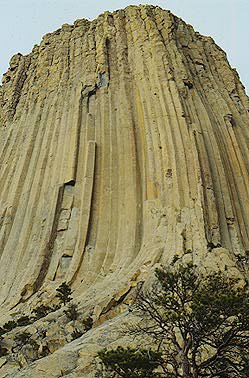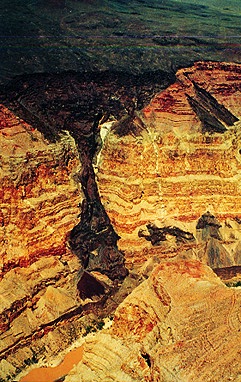Christina's Volcano Page
 Volcanoes are formed when the molten iron core and
thin crust deep inside of earth's surface also known as the mantle
melts and then it moves through the surface through the crust.
Volcanoes are formed when the molten iron core and
thin crust deep inside of earth's surface also known as the mantle
melts and then it moves through the surface through the crust.
High
temperatures and pressure cause the rock to melt and become hot liquid
rock~ also known as magma. When a large amount of magma has formed, it
rises through the layers toward Earth's surface. Magma that has come out
through the surface is then called lava. Since rocks are made of collections
of minerals that have melted at different temperatures, the makeup of the
rock will all be different.
Magma that has reached Earth's surface comes in 3 different compositions
they are basalt, Andesite, and Ryholite. Basaltic magma is the most common
form of magma. It forms from the partial melting of rock in the zone of
Earth's mantle also known as the asthenosphere. Basalt has the lowest amount
of silica. This makes is less dangerous than any other volcanoes.
Andesite can come in different ways. It is usually formed by the partial
melting of wet basalt. They often occur at colliding plate margins where
oceanic crust forms. It can also be formed by the melting of continental
crust. Andesite volcanos are usually more dangerous than basaltic because
they have more dissolved gasses.

(Inside a volcano)
Sanford Volcano

The Sanford volcano is located in Alaska. It is a large shield volcano.
There are no known eruptions. It is the highest volcano in the Wrangell
volcanic field. It is 11,733 feet tall ( from its base to its summit).
The upper part of the Sanford volcano is mostly covered with ice and snow.
The upper area is mostly younger than the rest of the volcano. The upper
area was most likely built on tops of three shield volcanoes. They
make up the north, west, and south eruptive centers. Lava from the volcano
are mostly made up of basalt and andesite.
Devil's Tower
 Devil's
tower is located in Wyoming. It's elevation is 5,112 feet. It's a
steep sided igneous body. It's magma is solid to a shallow level to about
700 to 3,000 feet below the surface. Erosion then stripped the overlying
layers of rocks away. The rock around the volcano are about 40 million
years old.
Devil's
tower is located in Wyoming. It's elevation is 5,112 feet. It's a
steep sided igneous body. It's magma is solid to a shallow level to about
700 to 3,000 feet below the surface. Erosion then stripped the overlying
layers of rocks away. The rock around the volcano are about 40 million
years old.
 The rock surrounding the tower is called a phonolite based on its mineral
composition. It includes anorthoclase, aegirine-augite, and sphene. Devil's
tower rises up to about 1,253 feet (382m) above Belle Fouche River. The
tower has columns which are mostly 5 sided. The columns formed from magma
while it was cooling from the surface downward.
The rock surrounding the tower is called a phonolite based on its mineral
composition. It includes anorthoclase, aegirine-augite, and sphene. Devil's
tower rises up to about 1,253 feet (382m) above Belle Fouche River. The
tower has columns which are mostly 5 sided. The columns formed from magma
while it was cooling from the surface downward.
Volcano Hazards

A volcanic hazard is the total probability of a specific area that will
be affected by a destructive volcanic process. Volcanoe eruptions aren't
necessarily all the same. They can be put into different categories. Many
eruptions produce fragmental rocks from erupting lava and surrounding country
rock. Some eruptions are dangerously explosive and produce volcanic ash.
Explosive eruptions sometimes cause widespread ash fall, pyroclastic flows,
debris, avalanches, landslides, pyroclastic surges, and lahars. For more
information click
here
Causes of Volcanos
Volcanos are caused when the rock deep inside the earth becomes so hot
that the rocks slowly melt and become a thick flowing liquid known as magma.
After it is erupted, it is then called lava. Since it is lighter than the
rock around it, magma rises and collects in magma chambers. Then some of
the magma gets pushed through the vents and out through the earth's surface.
Then the lava erupts. For more information click
here
Signs Of An Eruption
Most of the time, volcanos give out warning signs before they actually
erupt. Even though sometimes they can erupt without any type of warning.
Usually, slight shaking is felt before an eruption occurs. Seismometers
can detect and locate earthquakes that are associated with rising magma.
Swelling ground can be detected by using special instruments and special
techniques that measure the changes in slope, distance, or elevation at
the ground surface. For more information about this click
here.


 Volcanoes are formed when the molten iron core and
thin crust deep inside of earth's surface also known as the mantle
melts and then it moves through the surface through the crust.
Volcanoes are formed when the molten iron core and
thin crust deep inside of earth's surface also known as the mantle
melts and then it moves through the surface through the crust.


 Devil's
tower is located in Wyoming. It's elevation is 5,112 feet. It's a
steep sided igneous body. It's magma is solid to a shallow level to about
700 to 3,000 feet below the surface. Erosion then stripped the overlying
layers of rocks away. The rock around the volcano are about 40 million
years old.
Devil's
tower is located in Wyoming. It's elevation is 5,112 feet. It's a
steep sided igneous body. It's magma is solid to a shallow level to about
700 to 3,000 feet below the surface. Erosion then stripped the overlying
layers of rocks away. The rock around the volcano are about 40 million
years old.
 The rock surrounding the tower is called a phonolite based on its mineral
composition. It includes anorthoclase, aegirine-augite, and sphene. Devil's
tower rises up to about 1,253 feet (382m) above Belle Fouche River. The
tower has columns which are mostly 5 sided. The columns formed from magma
while it was cooling from the surface downward.
The rock surrounding the tower is called a phonolite based on its mineral
composition. It includes anorthoclase, aegirine-augite, and sphene. Devil's
tower rises up to about 1,253 feet (382m) above Belle Fouche River. The
tower has columns which are mostly 5 sided. The columns formed from magma
while it was cooling from the surface downward.


